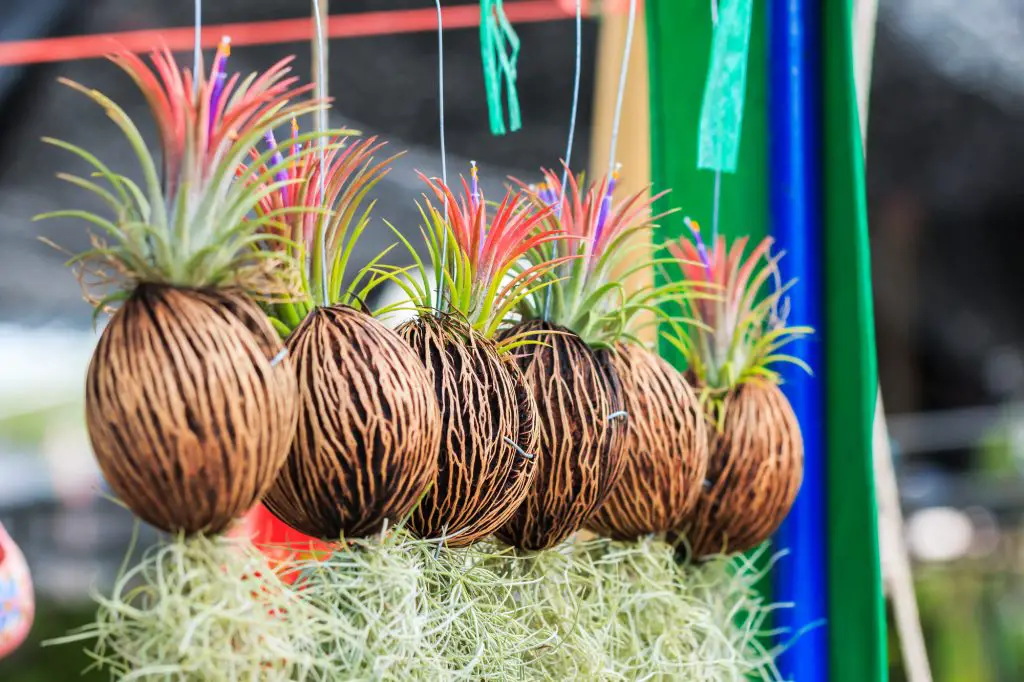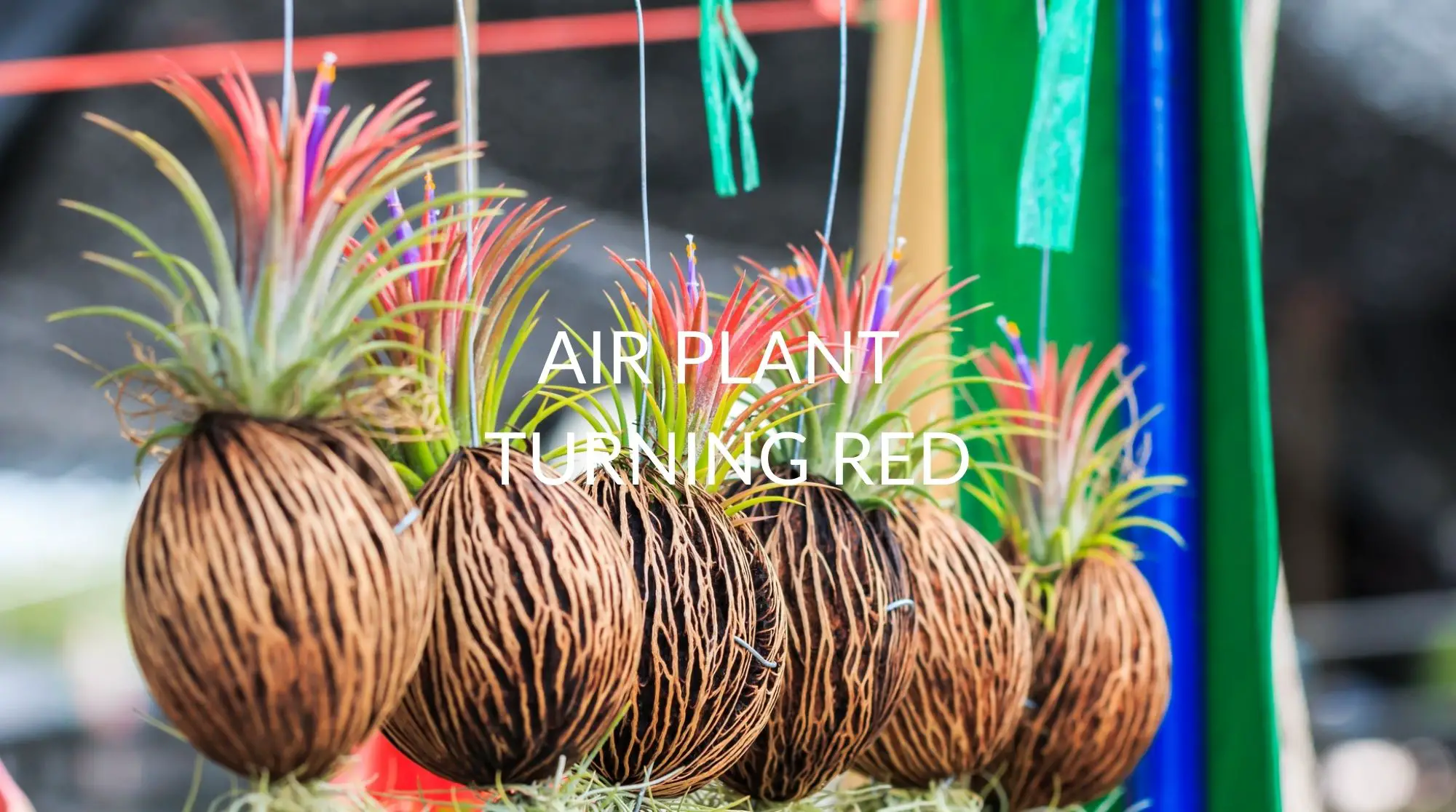Turning red or deep violet is normal for an air plant ready to bloom. The air plant will turn bright violet and promptly bloom a beautiful red flower. Unfortunately, the air plant can only blossom once in its lifetime. After blooming, they will die.
If you care for your plant properly, you may influence how quickly your air plant changes color from bright green to scarlet red. The best ways to care for your plant are by adjusting your watering and lighting techniques. Increasing or decreasing the amount of time your plant receives indirect sunlight can make a major impact on your plant’s health, and so can the type of light that it receives.
Pay close attention to your air plant’s health if they go through too many color changes. If the color change of your air plant is too dramatic, your air plant might be dying. Browning of leaves or lightening could mean that you need to evaluate your plant care, watering or
Why Is My Air Plant Turning Red?
If your air plant turns red, it could be a good sign it is ready to bloom. Air plants turn red before they bloom, so turning red can be a great sign for an air plant. A red air plant means you have taken great care of your air plant and have raised your air plant to full maturity.
Taking good care of your plant means properly misting your plant weekly and raising it in the right environmental conditions. Air plants require indirect sunlight, so you should place them somewhere in a bright place. You must always soak your air plant and give them supplemental lighting when necessary.
The only time you should be concerned about a red air plant is when the air plant shows signs of internal molding or dryness. Extreme dryness is often accompanied by browning. Browning can occur after your air plant turns red but is visibly different from the violet color change your plant goes through when healthy.
Sunlight Exposure
Exposure to sunlight can cause your air plant to turn red. Exposing your air plant to sunlight is a great thing because turning red means your plant is healthy and thriving. Ideally, you will expose your plant to indirect sunlight for at least twelve hours per day. If you have had too much sunlight exposure, the ends of your plant will brown.
Properly Watered
A properly watered air plant will turn red. Sufficiently watering your plant provides it with the necessary support it needs to thrive. Air plants only require a light misting each day to keep them hydrated.
They Are About to Bloom
Air plants will turn red right before blooming. The influx of nutrients in the air plant shows through the brightly blooming red flowers. After blooming, the bright red flower will sadly die.
Soaking
If you’ve soaked your air plant recently, it will probably turn red. Excess moisture can increase the rate your plant turns red. Submerge your air plant in water at least twice per week for one to two hours. Soaking your air plant any longer than one to two hours can cause overhydration to your plant.
Is The Air Plant Dying When It Turns Red?
Air plants are not dying when they turn red. Red air plants mean you have taken great care of your air plant, and the plant should soon sprout a bright red blossom. They are in their best living conditions and have sufficient water and lighting.
When an air plant is red, they are likely to blossom. They can bloom up to five bright red blooms. Unfortunately, the bright red plants bloom only once in their lives. After your plant blooms, it will die shortly afterward. So, when an air plant turns red, it is a sign of good plant care and, sadly, the end of its life.
What To Do When Your Air Plant Turns Red
Red air plants can be a sign of good plant care, so you should take the time to enjoy your healthy plant. You can enjoy the blooming plant or re-pot your air plant to enjoy it elsewhere. Some people change their watering habits because they do not want to overhydrate their matured plants.
When an air plant turns red, that means it is ready to bloom. Observe the bulbs that will bloom from the center of the air plant and be mindful that promptly after changing colors, the plant will die. So, you should appreciate the colorful plant while you can.
Enjoy the Bloom
Sit back and enjoy the blossoming plant while you can since this will be one of the last stages of the plant’s life. Air plants turn red and bloom only once in their lives, which is entirely natural and uncontrollable. The blossoms can be observed from afar without picking them or taking them from the plant.
Repot Them
Uprooting a red air plant and re-potting it elsewhere can be helpful if you want to pot your air plant while it is in bloom. Re-pot your air plant in a pot that brings you happiness to observe. Usually, the pot should be small and have a familiar aesthetic.
Maintain Care
Red air plants require continuous care if you want them to remain healthy and vibrant. The red air plant is either in bloom or close to blooming. Therefore, you should continue maintaining positive care for your plant until it dies. Expose your plant to indirect sunlight and heavily mist them until they are dripping with water.
Decrease Light Exposure
If your air plants are dark browning, you should decrease their light exposure. Turning red is a sign of good health, so you should maintain your positive plant care if you see this happen. However, a plant that continues to change color after turning red is an example of poor plant care. You should decrease the amount of direct sunlight you give your plants to improve their health and decrease the chance of sunspots.
Avoid Soaking
Avoid soaking a red air plant, or you may cause overhydration. Red air plants are typically fully-hydrated, with bright colors and beautiful blooming bulbs. If you soak your air plant while it is red, you may cause overhydration, molding, or killing your plant. When your air plant is fully mature, it is important that you adjust your plant care techniques so you do not kill them.
Keep the Bulb
Take time to wait and enjoy the bulbs that will blossom from the center of the air plant but do not remove any of the bulbs when they blossom. If you remove the blossoming bulbs, you will shorten the air plant’s life. Since a red air plant is already at the end of its life, you want to prolong the plant’s life as long as possible.

Can You Use Artificial Light For Red Air Plants?
Artificial light can be helpful for plants that are entirely devoid of lighting or that need supplemental light. Air plants must receive constant, daily lighting to mature and turn red. Artificial lighting can be the best way to support the lack of lights.
Raising plants with artificial lighting can speed the reddening process if you adhere to proper guidelines, but artificial lights do not provide the same nutrients as natural light. You should always opt for natural lighting when possible. When natural lighting is not available, artificial lighting can be a great alternative to sunlight.
Keep your air plants no further than three feet from the light for roughly twelve hours a day to encourage positive growth. Since air plants do not require any fertilizers, you can treat artificial lighting to supplement your air plant’s growth. Using artificial lights as a supplement is especially common in places where sunlight is scarce.
Recap
Air plants change colors as they mature from bright green to deep red. It is normal for the air plant to turn red right before blooming, so you should not be concerned if you see your plant turn violet or purple-red. A red air plant is a clear sign you have taken great care of your plant by watering it daily, giving it proper sunlight exposure, and raising it in the right conditions.
Adjusting your lighting and watering techniques can significantly impact how quickly your air plant turns red. If you are interested in manipulating the color of your plant, strategically alter the amount of light and water that your plant receives. Changing your plant care tactics can significantly help your air plant.
Air plants require indirect lighting for most of their day. If you want to grow air plants indoors in a place with little sunlight, you may use artificial lighting to grow your plants. Expose your air plants to artificial lighting for at least twelve hours per day if you do not have natural lighting, and your plants should mature to violet-red quicker than they would with natural sunlight. Remember, artificial lights do not provide the same nutrients as sunlight does.

